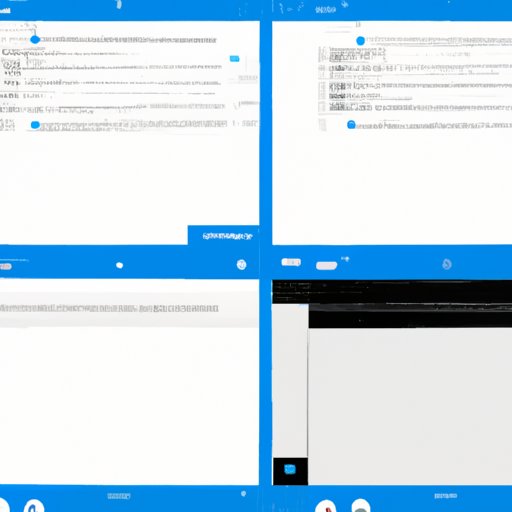I. Introduction
If you’re someone who frequently works with computers or mobile devices, you’re likely no stranger to screenshots. Screenshots, which are simply images of whatever is currently displayed on your screen, can be an incredibly useful tool for many reasons. Perhaps you need to share a quick snippet of a website with a coworker, or you want to capture a funny meme or social media post to send to friends. Whatever the reason may be, it’s important to know how to take a screenshot on whatever device you’re using.
II. Quick and Easy Guide to Taking Screenshots on Windows OS
Windows users have several options when it comes to taking screenshots. One common and easy way to take a screenshot is to use the built-in Snipping Tool. Here’s how:
- Open the Snipping Tool by clicking on the Start menu and typing “Snipping Tool” into the search bar.
- Once the tool is open, click the “New” button to start the screenshot capture process.
- Drag your mouse cursor over the area you want to capture. You can select rectangular, free-form, window, or full-screen capture options.
- After selecting the area you want to capture, the Snipping Tool will save the image, and you can then save it to your desired location.
If you prefer a different method, you can also take a screenshot on Windows by pressing the “Print Screen” button on your keyboard. This will capture a screenshot of your entire screen, and you can then paste it into an image editing program, such as Paint, to save the image.
III. Mastering the Art of Taking Screenshots: Tips and Tricks for Mac Users
Mac users also have built-in screenshot options, and the process is relatively simple. Here’s how:
- Press the “Command + Shift + 3” keys to capture a full-screen screenshot.
- Press the “Command + Shift + 4” keys to capture a specific area of your screen.
- After selecting the area you want to capture, the screenshot will be saved to your desktop.
If you’re using a newer version of macOS, you can also capture a screenshot using the built-in screenshot tool. Simply press “Command + Shift + 5” to open the tool and select the desired capture method.
IV. 3 Simple Steps to Capture Screenshots on Your Android Device
Android users can easily capture screenshots using a few simple steps:
- Press the “Power” button and “Volume Down” button on your device simultaneously.
- You’ll hear a camera shutter sound, and a notification will appear indicating that the screenshot has been captured.
- You can then access the screenshot from your device’s gallery or photo app.
Please note that the specific buttons you need to press may vary depending on your device and version of Android.
V. Expert Advice on Taking Screenshots on Your iOS Device
iOS devices also have a simple built-in screenshot tool. Here’s how to use it:
- Press the “Home” button and “Power” button on your device simultaneously.
- You’ll hear a camera shutter sound, and the screen will briefly flash white to indicate that the screenshot has been taken.
- You can then access the screenshot from your device’s gallery or photo app.
iOS devices also offer the option to take a screenshot with the “AssistiveTouch” feature. This can be accessed through the device’s accessibility settings.
VI. Customizing Screenshots: How to Edit and Enhance Your Screenshots
Once you’ve captured a screenshot, you may want to edit or enhance the image before sharing it. Several tools and programs can help you achieve this:
- Windows Paint: A simple built-in program for Windows users
- Microsoft Snip & Sketch: A newer tool that combines the functionality of the Snipping Tool and Paint
- Mac Preview: A built-in image editing program for Mac users
- Photoshop: A more advanced editing program available for Windows and Mac devices
- Various free and paid mobile apps, such as Adobe Lightroom, Snapseed, and Canva, available for Android and iOS
With these programs, you can crop, adjust brightness and contrast, add text, and manipulate your screenshots in a variety of other ways. Always remember to save your edited images in the appropriate file format.

VII. Sharing Screenshots Made Simple: A Guide on How to Share Screenshots with Friends and Family
Once you’ve captured and edited your screenshot, you may want to share it with others. Several methods can be used to easily share screenshots:
- Email: Simply attach the image to an email and send it to the desired recipient.
- Text messaging: Many smartphones allow you to attach images to text messages.
- Social media: Platforms like Facebook, Twitter, and Instagram allow you to share images directly from the app.
- Cloud storage: Services like Dropbox and Google Drive let you upload and share files.
Keep in mind that you may need to adjust the file format and size of your screenshot to ensure optimal sharing. For example, JPEG and PNG files are commonly used formats for sharing digital images.
VIII. Troubleshooting Screen Capture Issues: Common Problems and How to Solve Them
While capturing screenshots is generally straightforward, you may run into issues that prevent you from taking screenshots. Here are some common problems and how to solve them:
- Low storage space on your device: Clear out existing files or move files to another location to free up space.
- Outdated software: Make sure your device’s software is updated to the latest version.
- Screen capture restrictions: Some apps and websites may prevent you from taking screenshots. In these cases, try taking a photo of the screen with another device.
If you continue to have issues, consult your device’s instructions or contact customer support for assistance.
IX. Conclusion
Overall, taking screenshots is a simple process with several built-in options on both desktop and mobile devices. By following the steps outlined in this guide, you’ll be able to take, edit, and share screenshots with ease. Remember to check for any restrictions on taking screenshots and adjust your file format and size for optimal sharing.
